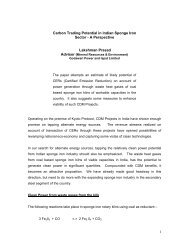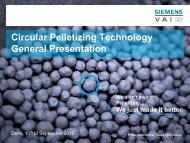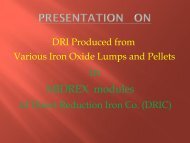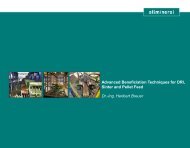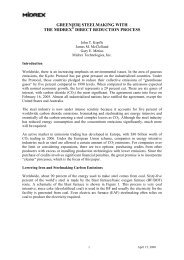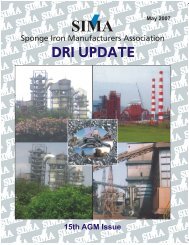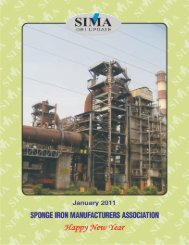December 2011 - SIMA
December 2011 - SIMA
December 2011 - SIMA
Create successful ePaper yourself
Turn your PDF publications into a flip-book with our unique Google optimized e-Paper software.
A new feeding system has been recently developedto further improve the separation sharpness and thethroughput capacity of cylindrical cyclones.Graspan Tri-Flo ® Plant / 1 MTPA /South Africa& Forests (MoEF) issuing to reduce the ash up to a35% level. The possible solutions available are heavymedia, jigging, dry washing, forth flotation etc. TheCoal processing plant includes the latest technologyin coal processing to increase the yield at thespecified quality. This paper will present the basis fordesign for coal washing with: (a) two-density heavymedium separation (Tri-Flo ® ).Tri-Flo ® Heavy Media separation:-The Tri-Flo ®is a compact multistage cylindricalseparator applied in difficult heavy mediumseparations or where a 3-product separation isrequired. Figure A reports a schematic view.The material is fed at atmospheric pressureseparately from the medium. The first stage floatmaterial directly enters the second stage for a secondseparation. In a difficult 2-product separation, onlyone Correct Medium (CM) is used and the secondstage further washes the float material for improvedseparation sharpness. Two CMs are used in a 3-product separation and the second stage operatesthe low gravity cut. Partition curves in Figure(illustrative only) show that the overall separation ofa rougher-cleaner circuit is improved if compared witha single stage separation and that an abnormal loadin the first stage causes some heavies to bemisplaced in the first stage float product but thesecond stage, which is workIng in more stableconditions since the first stage smoothes outvariations, can correct the situation.The Tri-Flo ® is aproven technology as indicated by many Tri-Flo ® pilotplants and more than 30 Tri-Flo ®industrial plantsexisting worldwide, mainly in mineral processing.Good Performance of Tri-Flo ®with High nearGravity MaterialThe Tri-Flo ® has been also tested with tracers duringthe Australian trials. Similarly, also the DSM cyclonewas tested with tracers in parallel with the Tri-Flo ®(note: the cyclone was gravity fed hence there wasno pump involved in feeding the cyclone with tracers).The result of the trial was that the tracers could beeasily collected from the Tri-Flo ® in a reasonable timewhile the test for the DSM cyclone was abandonedbecause many tracers (near gravity) had a very highretention time and could not be recovered in areasonable time. It was the Australian authorconclusion that the Tri-Flo ®can be more effectivewhen processing high near gravity material becausethis material does not accumulate and re-circulateinside the vessel. Against common belief that Ep isindependent from the amount of near gravity material.These materials have an effect on the sharpness ofseparation because the medium to coal ratiodecreases if material is retained inside the vessel.The simulations reported above where performedusing Ep obtained washing material with much lowernear gravity material if compared with the indian coaland, the results will become even more in favor ofthe Tri-Flo ® if a safety parameter is introduced to takeinto account the amount of near gravity material.DECEMBER-<strong>2011</strong>/33



